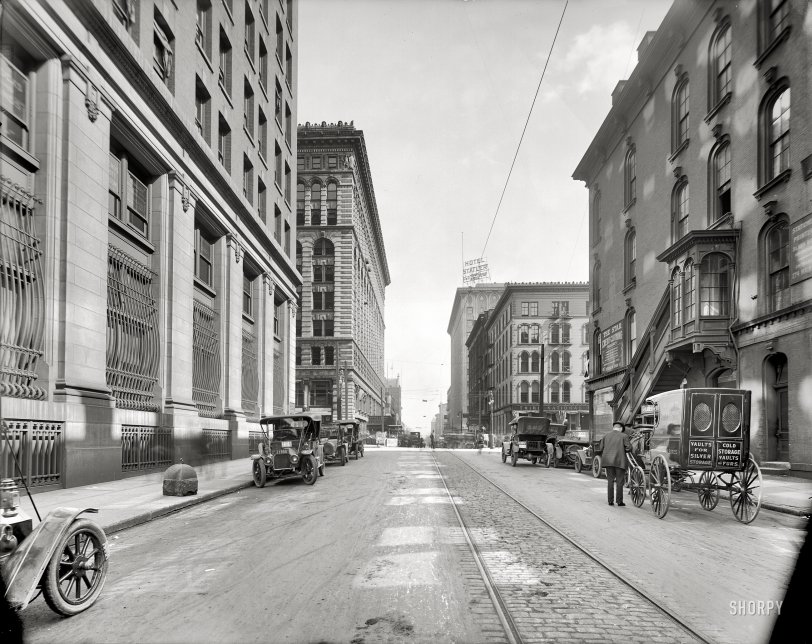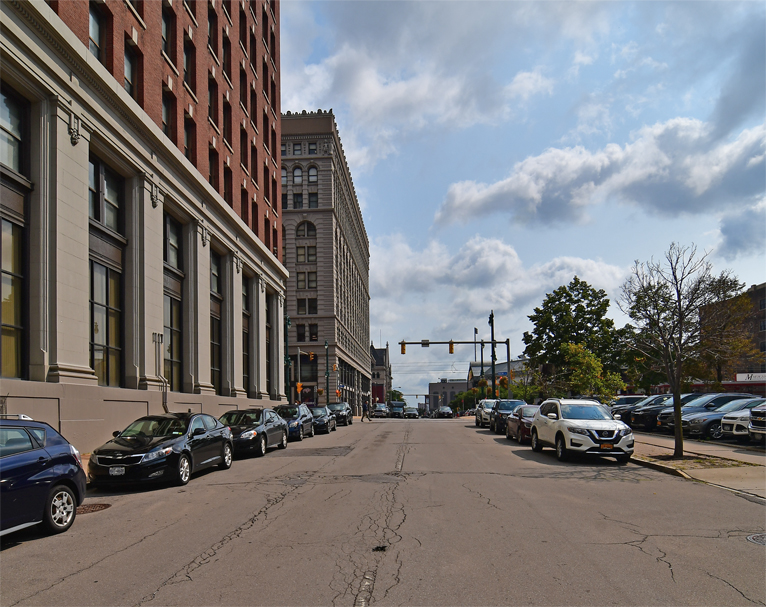


Framed or unframed, desk size to sofa size, printed by us in Arizona and Alabama since 2007. Explore now.
Shorpy is funded by you. Patreon contributors get an ad-free experience.
Learn more.

- Roll your own
- Rugged and real!
- A Charles Purcell - Mama Cass Connection
- Uncle SAAM
- Obfuscation
- One Chocolate Soldier rode away
- Victor Marquis de la Roche
- The Little House Across Way ...
- Vanderbilt Gates
- Vanderbilt Mansion
- You can still see that gate
- Withering heights for me
- So Jim,
- Top Heavy
- Re: Can't Place It.
- Bus ID
- Since you mention it
- The White Pages ?
- Moonlight Tower
- 1907?
- Fire(men) and Water
- Can't Place It
- Can anyone
- Wings
- Where's Claudette and Clark?
- Overbuilt Rolodex
- One song
- Give Me Wings Please!
- PRR
- Pinball Wizards
Printporium
Swan Street, Buffalo: 1911

Buffalo, New York, circa 1911. "Swan Street." The motorcar gains a foothold where hooves once trod on Swan in Buffalo. 8x10 glass negative. View full size.
+111
Below is the same view from September of 2022.

Multiple License Plates
Cars that traveled out of state were not automatically considered registered in their non-home state. We take for granded this reciprocity today.
Oftentimes you needed to acquire a temporary license plate or a permit to operate your vehicle in the state you were visiting. These license plates would differ by size, shape, and/or color to differentiate them from regularly issued plates.
Probably the owners of these vehicles worked in New York City and commuted from Ontario or vice versa. The use of multiple license plates can be found in many places including photos of New York City, with New Jersey or Connecticut license plates displayed, and in the District of Columbia with Maryland or Virginia license plates displayed.
Arched Windows
Arch-top windows don't need a steel lintel to hold the masonry above them. The masonry arch itself directs the downward force of the bricks or stones above out to the side. With a flat top you need to use steel or a very hefty chunk of stone over a very narrow opening to do the same thing. Glass for an arched window isn't very difficult to get, and even the window frame itself isn't particularly complicated as long as it's a wood window (metal windows or metal-clad windows are another story). Getting glass that's bowed out, like you see in the windows around some turrets, now that's difficult.
I figure the turn of the century is about the time that steel became cheap enough and well understood enough structurally to be used for window and door lintels. It certainly saves on masonry work, because you don't need to build wood falsework to form the arch, nor do you have to cut the many bricks to fit around that arch. Unfortunately, these steel lintels need to be painted and maintained, because if they start to rust they break up the masonry around them and are a huge pain to replace.
Parking against the kerb
I was always taught (in UK, and I don't think kids these days are taught it anyway) that if you are parking on a downwards slope against the kerb, then turn the wheels inwards so that if the handbrake gives then the vehicle would only roll towards (and be stopped by) the kerb. The car in the centre of the picture would roll out across the highway.
Tire patch
Wonderful tire patch. THE most important historic element in the photo.
The Hotel Statler
built in 1907 at Swan and Washington Streets was Ellsworth Statler's first hotel. Although still owned and operated by Statler, it became the Hotel Buffalo in 1923 when the new Statler at Niagara Square opened (built where the Castle Inn had stood). Hotel Buffalo was sold in the 1930s. It was closed in 1967 and demolished in 1968. The land was vacant until what is now Coca-Cola Field was built in 1988.
Looking at windows
One of the ways you can tell if a building is from the 1800s or not, is if it has arch-top windows. Obviously they knew how to make flat-top windows then. The top floors of the buildings shown here have them. The 1907 hotel Statler has them entirely.
Obviously they didn't abruptly stop making them on December 31, 1899. But for the most part, you can date a surviving old brick building when it has those windows.
The building in the right foreground is a classic round-top masonry example that would have been around during the Civil War. I love it, especially the windows. (Though I'd hate to try and get a 2011 glass man to replace one of those upper panes).
Was it just fashion that made so many buildings have this look, or was there something structural all those keystones added to the masonry, which the flat top windows do not give the walls?
Right Hand Drive
Of the cars where the steering wheel can be seen, all three have right hand drive. Surely they weren't all imported from eg. Europe? When did LHD become standard in the US?
[There was a gradual transition from a mix of left- and right-hand drive cars. - Dave]
Vaults
I love the carriage all the way on the right. "Vaults for Silver storage. Cold Storage Vaults for furs." Not a fancy motorized vehicle but instead an old fashioned carriage with wooden wheels.
Tagged
The cars have two license plates. Why izzat?
[One for New York and one for Ontario. - Dave]
Meep! Meep!
Why am I imagining that Wile E. Coyote is somewhere under that great block of stone on the curb?
Anchor? Horse-hitch? Something to do with the ghostly passers-by?
Nice Truss!
That's an optimistic tire patch, and it doesn't look home-made. Could it be a Patented Herniated Tire Belt?

Elllicott Square Building
A block up the street on the left is the Ellicott Square Building. When it was built, in 1896, it was the largest office building in the world.
























On Shorpy:
Today’s Top 5